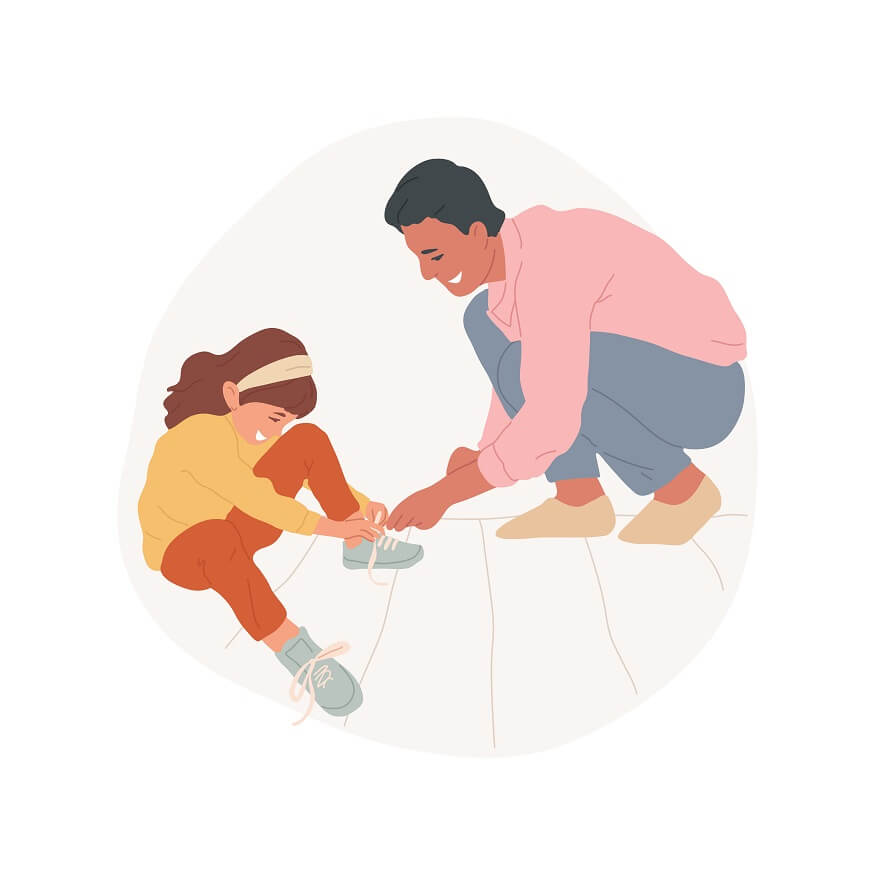Teaching a child to tie their shoes can be a milestone in their development. It’s a task that requires dexterity, coordination, patience, and understanding of a sequence. Here are the steps you might follow to help your child master this essential skill.
Also Read: How Do You Teach Kids the Importance of Life Skills
Choose the right shoes: Before starting, ensure your child has a pair of shoes with laces that are easy to handle. The laces shouldn’t be too slippery, and the eyelets should be big enough to pull the laces through.
Find the right time: Find a quiet, calm moment without any distractions. Ensure you’re both in a comfortable and relaxed state. This might take more than one session, so patience is key.
Demonstrate first: Start by showing them how you tie your shoes. Explain each step as you go. Show them the end product so they have an understanding of what they are trying to accomplish.
Practise with them: Have them practise the steps you’ve shown. They may struggle initially, but with a bit of practice, they should become more confident.
Reinforce and practice: Patience and repetition are essential here. Celebrate their successes, even the small ones, and encourage them when they find it difficult.
Allow them to do it on their own: Once they seem comfortable with the process, have them try it on their own shoes.
Use rhymes or stories: Children may find it easier to remember the steps if they are part of a rhyme or story. For example, with the ‘bunny ears’ method, you could tell a story about a bunny going around a tree and into a hole.
Remember, each child learns at their own pace, so don’t worry if your child doesn’t pick this up immediately. Keep the sessions fun and stress-free. With time and practice, your child will master this skill.
Also Read: Playground Safety for Children – Rules and Precautions
How to tie shoelaces – Various methods
There are numerous ways to tie shoelaces, each method having its own advantages. Here are a few popular methods:
Traditional or “Bunny Ears” Method:
- Make a ‘bunny ear’ loop with each lace.
- Cross the ‘ears’ over each other.
- Bring one ‘ear’ under the other and through, pulling it out on the other side.
- Adjust the ends of the bow to the size you prefer.
- This method is simple and commonly taught to young children.
“Loop, Swoop, and Pull” or “One Loop” Method:
- Create a loop, or ‘bunny ear’, with one lace and hold it up.
- Take the other lace and ‘swoop’ it around the ‘loop’.
- Push a bit of the ‘swooping’ lace through the hole created when they swooped it around the loop, forming the second loop.
- Pull both loops tight to secure.
- This method is also child-friendly and requires less dexterity than the “Bunny Ears” method.
Ian Knot or “Fast” Method:
- Start as if you’re doing the traditional method, but instead of making two loops (or ‘bunny ears’), make two small ‘loops’ by simply folding the lace back on itself.
- Cross the right loop over the left, forming an “X”.
- Push the ends of the loops through the ‘loop’ in the middle of the “X”.
- Pull the loops tight.
- This is considered one of the fastest ways of tying shoelaces, though it may require some practice.
“Around the Tree” Method:
- Begin with a regular starting knot.
- Make a loop (the ‘tree’) with one lace, then circle the other lace around it (this is ‘going around the tree’).
- Feed the circling lace through the hole that forms under the loop.
- Pull on both ends to create a tight knot.
- This method is known for its tight and secure knot.
“Double Slip Knot” Method:
- Make a ‘bunny ear’ with one lace.
- Wrap the other lace around the ‘bunny ear’ twice.
- Feed a bit of the second lace through the loop that’s created.
- Pull on both loops to tighten the knot.
- This method forms a secure knot that can still be easily untied by pulling the free ends.
These are just a few of the many ways to tie shoelaces. Each method has its own strengths and weaknesses, and some are better suited to certain situations or types of footwear than others. Experiment with these methods to see which one you prefer!
Also Read: The Importance of School Education
What to do if the child has trouble tying shoes
If your child is having trouble learning to tie their shoes, it’s important not to worry. Every child learns at their own pace and fine motor skills develop over time. Here are some strategies you can use to help:
Practice on something larger: Sometimes it helps to start big. You can use a rope and a large cardboard cutout of a shoe or a real-life adult shoe. Once they’ve mastered that, they can move on to their own shoes.
Improve fine motor skills: Tying shoelaces requires fine motor skills. Encourage your child to play with playdough, use scissors, do some colouring, or string beads to develop these skills.
Use different coloured laces: Use a shoe with two different coloured laces to help your child see what they are doing. This can help them understand which lace goes where.
Try a new method: If one way of tying shoes isn’t clicking with your child, try another. The “loop, swoop and pull” or the “bunny ears” methods are most common, but there are others, like the “magic fingers” technique, that your child might find easier.
Break it down: Make sure you break down the process into small, manageable steps. Try teaching one part of the process at a time.
Make it a routine: Practice regularly, such as every morning before school or every evening before bed. Regular practice will help your child master the skill.
Stay positive and patient: It’s important to keep the mood light and positive. Praise your child’s efforts and progress, and remind them that it’s okay if they don’t get it right away.
Use tools: There are numerous tools and toys on the market designed to help children learn to tie their shoes.
Consider Velcro or slip-ons: If your child is getting frustrated, it may be best to put aside lace-up shoes for a while. Use Velcro or slip-on shoes until your child is a bit older and ready to try again.
Remember, the goal is for your child to learn this skill without feeling pressured. It might take some time, but with patience and practice, they’ll eventually master it.
Also Read: What are Motor Skills and Why is it Important?
Euroschool believes that by teaching basic skills, they are giving children the foundation they need to succeed in school and in life.











